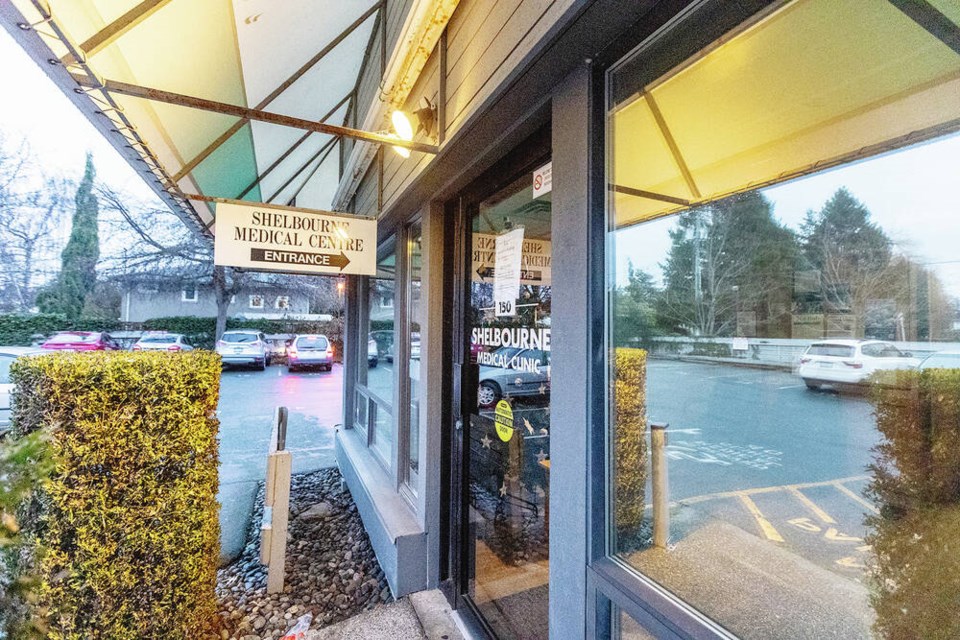Another medical clinic in the capital region will soon close due to a physician shortage, leaving nearly 4,000 patients without a family doctor in the new year.
Shelbourne Medical Clinic, located beside Hillside shopping centre in Victoria, will permanently close on March 31, 2024.
Dr. Lorne Verhulst, 69, is retiring next year after 45 years — about half that time as a front-line clinician. He said he’s worried about what will happen with his patients.
“It really breaks my heart that they are going to be left in the lurch,” Verhulst said in an interview on Monday.
Shelbourne Medical Clinic, at 150 – 3200 Shelbourne St., has two part-time physicians, including Verhulst, who works about 25 hours a week, and one full-time doctor. Without a replacement for Verhulst, it is “not viable” for the remaining two to run the practice, he said.
About five years ago, the family practice clinic switched to a walk-in clinic open five days a week due to the physician shortage.
“In an ideal world, I would have been working in a bigger organization that would take charge of [my patients’] care and would recruit another doctor to fill my position as I retired, as would normally be the case in most other industries,” said Verhulst.
“But here we have a cottage industry of little mom-and-pop shops all over — privately run and publicly funded — and there’s just no legs under them.”
The clinic registered 28,000 visits over the last two years by about 8,700 patients, of whom 3,800 visited more than three times and “consider us to be their regular source of primary care,” said Verhulst.
In a Dec. 15 letter, patients were advised to become established at another clinic prior to the closure of the Shelbourne clinic.
It’s estimated that one in five or one million people in the province are without a family doctor — more than double the 437,000 people without a family physician in B.C. two decades ago.
Last year, of about 6,400 doctors in B.C., only about 3,400 were working as full-time family-practice doctors. Many chose hospitalist or other specialty positions with better pay and working conditions.
After Shelbourne Medical Clinic closes, original patient records will be stored at a medical records facility, where patients can retrieve them for a “non-prohibitive” cost.
Verhulst notes that the clinic’s lease is due for renewal next summer and the lease-holder wants a five-year commitment, which Verhulst said he can’t make. The monthly rent now is $3,600 and doesn’t include clinic overhead expenses such as utilities and equipment.
Verhulst said the province and medical community are making strides in training and hiring more physicians, but it’s a slow process.
“It’s gradually getting better,” he said. “But we’re still among the victims of the transition right now.”
For now, he said, there is a split between “first-class patients who have a family doctor” and “everybody else who has second-class access to care, and I don’t think that that’s right because we’re all paying the same amount of taxes.”
Verhulst maintains the primary-care system needs to operate within a larger organization — whether run by health authorities or community organizations — that can survive the attrition of retiring doctors and shifts in human resources and has the help of enough allied health professionals to allow family doctors to have bigger, but reasonable, work and case loads.
“We need to change the system so we organize primary care in a more comprehensive way rather than relying on small independent contractors to deliver care,” said Verhulst.
Verhulst said that organization could also resemble school boards or local government, with a mandate to enroll people in primary health care where they live, similar to school enrolment.
“Can you imagine a system in which you go to enroll little Johnny in Grade 2 and the school says: ‘I’m sorry, we’re not taking new pupils right now?’
“We wouldn’t put up with that, but you have to put up with that in medicine,” said Verhulst. “I can’t understand it.”
This year, the province and Doctors of B.C. introduced a $708-million, three-year deal that includes a new payment model that it hopes will attract and retain family physicians.
Despite the physician shortage and all that has come with that, Verhulst said he’s had a rewarding career and would recommend it to others, cautioning only that any new doctor would have to go in with their eyes “wide open.”
“It’s not just for the money that you would want to do this job,” he said.
• Patients needing urgent care can visit one of Greater Victoria’s six Island Health-run Urgent and Primary Care Centres. Details on UPCCs can be found on the HealthLinkBC website: https://www.healthlinkbc.ca/health-services/urgent-and-primary-care-centres
• Anyone without a family doctor can sign up for the provincial Health Connect Registry, which matches unattached patients with family physicians and nurse practitioners: https://www.healthlinkbc.ca/health-connect-registry



-thumb.png;w=120;h=80;mode=crop)